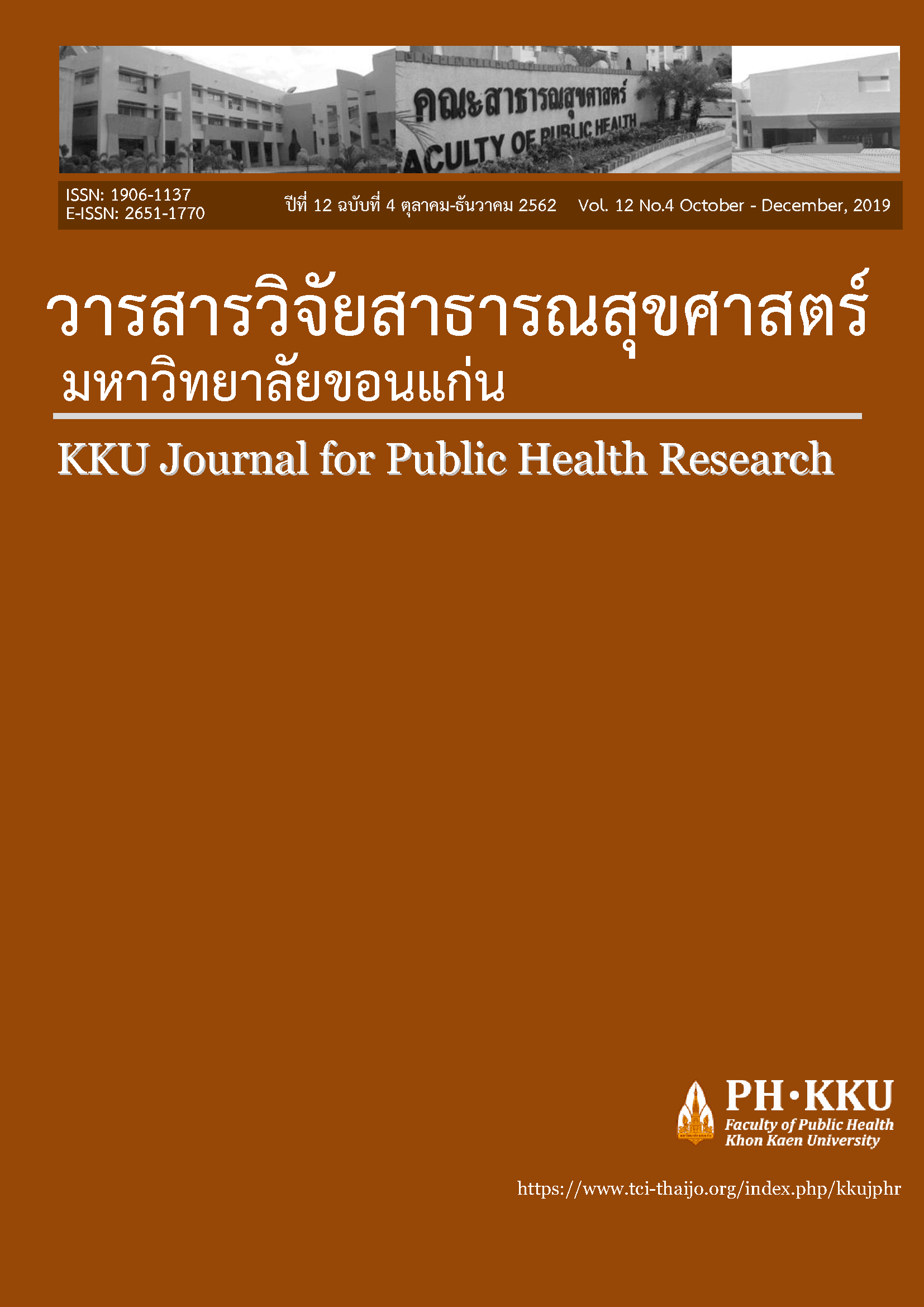Health Risk Assessment on Particulate Matter (PM10) Exposure among Electricity Generating Authority of Thailand (EGAT) Restaurant Workers
Keywords:
Indoor Air Pollution, Dust from Cooking, Hazard in The Kitchen, PAHs, PM10Abstract
Cooking process at kitchen which are the process for burn and stir-frying food causes emission of the indoor air pollution, especially particulate matter (PM10) and polycyclic aromatic hydrocarbon (PAHs). Exposures to PM10 and PAHs lead to in several health impacts of kitchen workplace attendants. This study aimed to assess PM10 concentration level in the kitchen workplaces and symptoms due to exposure to PM10 and PAHs and to conduct to qualitative health risk assessment. Data were collected by the questionnaire and PM10 monitoring the kitchen ambient air. The result showed that PM10 concentration level in all workplaces were less than ministry of labor standard (Thailand). The symptoms which were reported due to expose with cooking dust in last six months showed that most of workers had symptoms at the moderate severity level (52.46%) and mild severity level (27.87%). On the other hand, a high severity level was reported in the chef position (1.64%). Correlation analytic for investigation of the factors that significantly associated with abnormal symptoms were exposure to cooking dust in the kitchen and working without personal protective equipment factors (p-value < 0.05). The potential health risk on restaurant involved workers showed that all workers had health risk from PM10 and PAHs exposure in difference level as quite high level to very high level. Considering worker’s position, the results showed that chef had health risk at high level (77.77%), quite high level (16.67%) and very high level (5.56%). All chef assistant had health risk at high level (100%). Waitress had health risk in high level (88.64) quite high level (11.54%). Cashers had health risk in high level (54.55) quite high level (45.55). Despite, PM10 concentration level were under the labor standard permission, workers had reported health impact symptoms due to exposure to dust from cooking process which might be embedded with form of PAHs and other hazardous substances. For safely working in the kitchen, all workers shall be recognized in PM10 and PAHs hazard, use personal protective equipment and improve the workplace for safety condition.
References
กรมควบคุมมลพิษ. (2547). พีเอเอช (โพลีไซคลิก อะโรมาติก ไฮโดรคาร์บอน) (พิมพ์ครั้งที่ 2). กรุงเทพฯ: ไอเดีย สแควร์.
กรมควบคุมมลพิษ. (2557). สถานการณ์มลพิษประเทศไทย ปี 2558 รอบ 6 เดือน. ค้นเมื่อ 5 พฤษภาคม 2560, จาก http://infofile.pcd.go.th/mgt/ThailandPollut2558_Form.pdf?CFID=3783417&CFTOKEN=77823116
กรมธุรกิจการค้า. (2560). ธุรกิจภัตตาคาร/ร้านอาหาร. ค้นเมื่อวันที่ 6 กันยายน 2561, จาก http://www.dbd.go.th/download/ document_file/Statisic/2560/T26/T26_201703.pdf
กระทรวงสาธารณสุข. (2558). แนวทางการเฝ้าระวังพื้นที่เสี่ยงจากมลพิษทางอากาศกรณีฝุ่นละอองขนาดเล็ก. ค้นเมื่อ 20 กรกฎาคม 2560, จาก http://enhealthplan.anamai.moph.go.th/ewt_dl_link.php?nid=24
กระทรวงอุตสาหกรรม. (2555). ประกาศกระทรวงอุตสาหกรรม ฉบับที่ 4428 (พ.ศ.2555) ออกตามความในพระราชบัญญัติมาตรฐานผลิตภัณฑ์อุตสาหกรรม พ.ศ. 2511 เรื่องกำหนดมาตรฐานผลิตภัณฑ์อุตสาหกรรมการเก็บและวิเคราะห์อนุภาคแขวนลอยในอากาศในสภาวะแวดล้อมการทำงาน. ราชกิจจานุเบกษา, 129(129ง), 8
กระทรวงแรงงาน. (2560). ประกาศกรมสวัสดิการและคุ้มครองแรงงาน เรื่อง ขีดจำกัดความเข้มข้นของสารเคมีอันตราย. ราชกิจจานุเบกษา, 134(198ง). 34.
ปณิดาภา แก้วสวน. (2557). ความสำเร็จของนโยบายครัวไทยสู่ครัวโลกภายใต้ความร่วมมือระหว่างภาครัฐและเอกชน. [ฉบับอิเล็กทรอนิกส์]. วารสารวิจัย มสด สาขาวิทยาศาสตร์และเทคโนโลยี, 10(1),47-57
รัชนี นันทนุช, & สุนิสา ชายเกลี้ยง.(2556) ความเสี่ยงด้านสุขภาพต่อการได้รับอันตรายจากการสัมผัสน้ำมันเชื้อเพลิงของพนักงานสถานีบริการน้ำมันเชื้อเพลิงในเขตเทศบาลนครขอนแก่น: การศึกษานำรอง. ศรีนครินทร์เวชสาร, 28(4), 506-515
สุนิสา ชายเกลี้ยง. (2557). พิษวิทยาสาธารณสุข. ขอนแก่น: โรงพิมพ์มหาวิทยาลัยขอนแก่น
อารุญ เกตุสาคร, & นรุตตม์ สหนาวิน. (2560). ความสัมพันธ์ระหว่างสารโพลิไซคลิกอะโรมาติก ไฮโดรคาร์บอนและPM10 กับปัจจัยด้านสภาพแวดล้อม:กรณีศึกษาในสถานประกอบพิธีกรรมทางศาสนาในจังหวัดปทุมธานี [ฉบับอิเล็กทรอนิกส์]. วารสารวิชาการพระจอมเกล้าพระนครเหนือ, 27(3):1-8.
Frederic, L., & Michael, B. (2010). A short primer on benzene, toluene, ethylbenzene and xylenes (BTEX) in the environment and in hydraulic fracturing fluids. Retrieved September 10, 2018, from https://ehp.qld.gov.au/management/coal-seam-gas/pdf/btex-report.pdf
Kuo, P. Y., Ke, R. Y., Yen, C C., Jia, Y G., Yen P C., Hui, C S., et al. (2015). Indoor air pollution from gas cooking in five Taiwanese families [Electronic version]. Building and Environment, 93(2), 258-266.
National institute for Occupational Safety and Health [NIOSH]. (1998). Particulates not otherwise regulated, respirable 0600. Retrieved September 8, 2018, from https://www.cdc.gov/niosh/docs/2003-154/pdfs/ 0600.pdf
United States Environmental Protection Agency [US EPA]. (2018). Health and environmental effects of particulate matter (PM). Retrieved September 5, 2018, from https://www.epa.gov/pm-pollution/health-and-environmental-effects-particulate-matter-pm
World Health Organization [WHO]. (2018). Risk factors for chronic respiratory diseases. Retrieved September 8, 2018, from http://www.who.int/gard/publications/Risk%20factors.pdf
Yu, H., Steven, S H., Kin, F H., Shun, C L., Jian, Z Y., & Peter, K.K. (2011). Characteristics and health impacts of VOCs and carbonyls associated with residential cooking activities in Hong Kong [Electronic version]. Journal of Hazardous Materials 186(1) 344–351


